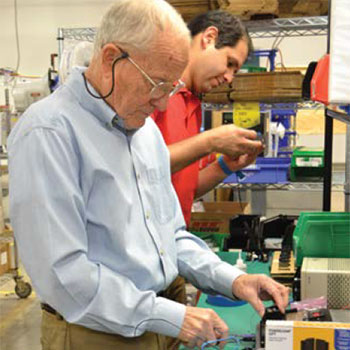 ABOUT LELAND J. HANCHETT JR.
ABOUT LELAND J. HANCHETT JR.
Having worked in the computer peripherals field for 16 years, in 1976, Hanchett decided
to try his hand at running his own business to produce electrified lock hardware.
Hanchett Entry Systems Inc. grew steadily for 22 years at which point he sold his company
indirectly to ASSA ABLOY.
After trying retirement for a few years, he decided that creative electro-mechanical
design work was part of his fiber. In 2007, he resumed inventing and designing devices
used in access control for his former company.
Hanchett has more than patents in the
fields of electronics, mechanics, optics and bar code reading.
Hanchett has a passion for Arizona history and has written several books on the subject.
‘Catch the Stage to Phoenix’ is a recommended read.
Hanchett holds a BA in electrical engineering from Southern California and a Masters in
engineering from Arizona State University.
He currently resides in Phoenix.
It all started in Boston—a young,
motivated inventor trying to meet
the particular customer demand of
a new electric strike design that could
handle a 1-inch deadbolt. With an inherent
spark for solving problems, this
inventor, Lee J. Hanchett Jr., decided to
address this particular issue by turning
his very own door into a workshop.
His persistence and determination
paid off; and, in 1975, he created the
most popular electric strike to date,
capable of releasing a 1-inch deadbolt,
the HES 1003. Six months later,
in 1976, Hanchett patented this electric
strike and founded Hanchett Entry
Systems (HES), which later became a
part of the ASSA ABLOY Group of
companies in 1999.
The 1003 was Hanchett’s first key
breakthrough and remains the best-selling
electric strike that HES builds today.
It became a strong and versatile product
that helped HES get off the ground,
and it was the lead product that began
his relationship with ASSA ABLOY.
Hanchett’s influence has since grown beyond
HES and impacts the development
of many products, including the most
recent creation and deployment of the
revolutionary Securitron PowerJump.
Hanchett feels that this is one of the biggest
breakthroughs of his career.
After a conversation with Michael
Webb, HES vice president, who set him
on a mission to design a product that
would be able to transfer power across a
door without physical contact, Hanchett
began to research, reading countless
articles to figure out how other people
handled a regular wire transfer with
items like toothbrushes, cell phones and
laptops as the core foundation. Hanchett
realized that by redesigning the circuits,
he could make power transfer across the
gap, effectively jumping power between
the two parts.
While developing the PowerJump,
the biggest problem encountered was
that earlier wireless power transfers had
a fixed distance between transmitter
and receiver, making it easier to design
something that would work correctly.
Between the door and frame, however,
the size of the gap can vary widely,
which was challenging.
The overall outcome couldn’t have
been better, though, resulting in a
first-of-its-kind product that is able to
deliver power contactlessly and invisibly
between the frame and door to
power almost any kind of electrified
hardware. Installed at the latch side or
hinge side of the door, without pins or
wires across the door gap, the PowerJump has eliminated all points of wear,
breakage and vulnerability, and no
longer requires core drilling the door.
Hanchett believes that the PowerJump
is the perfect device for retrofitting
electrified locks into existing openings
or for a new installation in aluminum,
metal or wooden doors.
Looking toward the future,
Hanchett believes without a doubt that
microcontrollers and the art of embedding
them is the next big thing. He predicts
that the competitive environment
will fuel this process by creating smaller
and smaller packaging with smart technology
on board and microcontrollers
in everything we touch.
With so much potential in this area,
Hanchett isn’t planning on leaving his
passion for technology any time soon.
Hanchett’s father always said, “If you
want to get anything done, you have to
keep everlastingly at it.” He took that
to heart; his goal has been to create one
new product every year.
At 75 years old, Hanchett holds approximately
25 patents across various
disciplines, and has the same determination
to fix problems, conduct research
and find ways to do things that
others haven’t thought of yet.
“You must keep working hard so
that you never think you reach the
pinnacle, or you will go downhill,”
Hanchett said.
We can hardly wait to see what he’ll
come up with next.